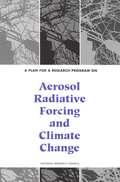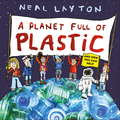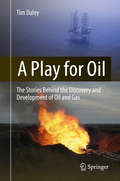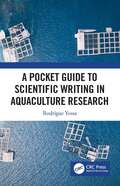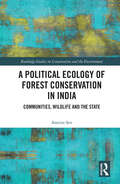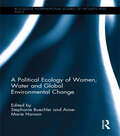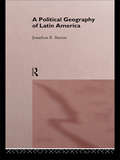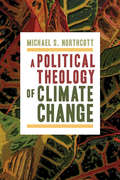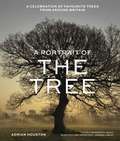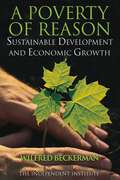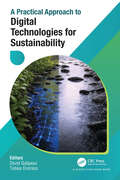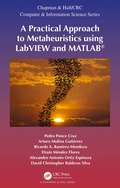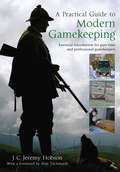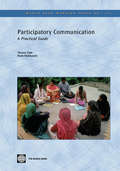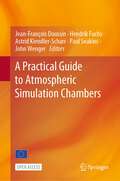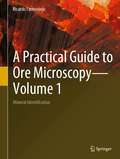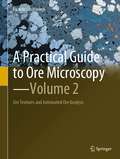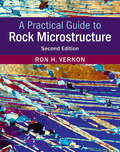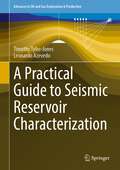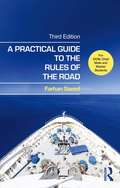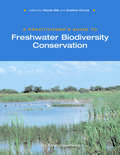- Table View
- List View
A Plan for a Research Program on Aerosol Radiative Forcing and Climate Change
by National Research Council StaffThis book recommends the initiation of an "integrated" research program to study the role of aerosols in the predicted global climate change. Current understanding suggest that, even now, aerosols, primarily from anthropogenic sources, may be reducing the rate of warming caused by greenhouse gas emissions. In addition to specific research recommendations, this book forcefully argues for two kinds of research program integration: integration of the individual laboratory, field, and theoretical research activities and an integrated management structure that involves all of the concerned federal agencies.
A Planet Full of Plastic: and how you can help
by Neal LaytonEverything is made of stuff. Some things are made of paper, like this book. And some things are made of PLASTIC. If you look around you, plastic is everywhere. Even in places where it's not meant to be. If it drops to the ground, it doesn't rot away - it sticks around for ever.Our world is drowning in plastic, and it's a big problem. Award-winning author-illustrator Neal Layton is here to explain where plastic comes from, why it doesn't biodegrade, and why that's dangerous for animals and humans alike. But he's also FULL of ideas for how you can help! From giving up straws in juice cartons to recycling all we can and taking part in a beach clean, A Planet Full of Plastic will get young readers excited about how they can make a difference to keep Planet Earth happy.This brilliant non-fiction picture book, illustrated in Neal's trademark collage style, is perfect for readers aged 5-7 who love nature and want to help the environment.
A Play for Oil: The Stories Behind the Discovery and Development of Oil and Gas
by Tim DaleyYou hold in your hands the most original guide to understanding the oil and gas world - from exploration and production to the related economics and geopolitics. Tim Daley has spent years travelling the world and living as an expatriate in a quest to secure resources and meet humanity's energy demands. After several decades in the hydrocarbon business, he was keen to write a book about his experiences in an easily accessible language, enabling everyone to grasp the technicalities involved in evaluating the resources that lie beneath our feet. If you want to learn how hydrocarbons are discovered and produced, Tim's explanations have the added colour of vivid descriptions of the sites discussed and allow you to meet some of the most important characters in the industry, and to gain new insights into this global industry. In addition, the depictions of key events and locations add an element of national politics and travelogue feel. This book is intended for all members of the general public interested in how hydrocarbon resources are discovered, providing a concise account of how oil geologists view the subsurface, and illustrated by the author's personal experiences in countries around the world. The book will also be of interest to ex-oil industry workers, allow geologists to compare the author's experiences to their own, and provide non-geologists essential insights into how the oil is won. Written in an informal style, it makes for a relaxing yet informative reading experience.
A Pocket Guide to Scientific Writing in Aquaculture Research
by Rodrigue YossaWriting for a high-quality scientific aquaculture publication is challenging, and many students and early career aquaculture scientists find the task daunting. Expanding on his popular workshop on Improving Scientific Writing at the 2017 World Aquaculture conference, Rodrigue Yossa provides new researchers with all the tools they need to write abstracts and a variety of articles (original, research reports, magazines, working papers, conference proceedings and more). He also takes the reader step-by-step through the process of reviewing submitted manuscripts and replying to reviewers, as well as understanding research ethics. Each section is accompanied by examples, and attention is focused on providing advice on grammar, how to focus your paper and possible loopholes when writing. A Pocket Guide to Scientific Writing in Aquaculture Research offers a lifeline to aquaculture students and early career researchers getting a grasp on the basics of science communication through writing.
A Polar Dictionary: Cold Words
by Dr Bernadette HinceThis 'ice-breaking' book collects the English words of the Antarctic and the Arctic for the first time. These words relate to weather, ice and snow, auroras, clothes, food, housing, social structures, wildlife, plants, politics, as well as many other aspects of polar life. The terms are presented with scientific precision, a helpful interpretative commentary and moments of irresponsible whimsy. Apart from Antarctica and the Arctic, the regions covered here stretch to places as remote as the Faroe Islands, Iceland, Tristan da Cunha and the Falkland Islands.
A Political Ecology of Forest Conservation in India: Communities, Wildlife and the State (Routledge Studies in Conservation and the Environment)
by Amrita SenThis book critically explores the political ecology of human marginalization, wildlife conservation and the role of the state in politicizing conservation frameworks, drawing on examples from forests in India. The book specifically demonstrates the nuances within human-environmental linkages, by showing how environmental concerns are not only ecological in content but also political. In India a large part of the forests and their surrounding areas were inhabited far before they were designated as protected areas and inviolate zones, with the local population reliant on forests for their survival and livelihoods. Thus, socioecological conflicts between the forest dependents and official state bodies have been widespread. This book uses a political ecology lens to explore the complex interplay between current norms of forest conservation and environmental subjectivities, illustrating contemporary articulation of forest rights and the complex mediations between forest dependents and different state and non-state bodies in designing and implementing regulatory standards for wildlife and forest protection. It foregrounds the issues of identity, migration and cultural politics while discussing the politics of conservation. Through a political ecology approach, the book not only is human-centric but also makes significant use of the role of non-humans in foregrounding the conservation discourse, with a particular focus on tigers. The book will be of great interest to students and academics studying forest conservation, human–wildlife interactions and political ecology.
A Political Ecology of Women, Water and Global Environmental Change (Routledge International Studies of Women and Place)
by Stephanie Buechler Anne-Marie S. HansonThis edited volume explores how a feminist political ecology framework can bring fresh insights to the study of rural and urban livelihoods dependent on vulnerable rivers, lakes, watersheds, wetlands and coastal environments. Bringing together political ecologists and feminist scholars from multiple disciplines, the book develops solution-oriented advances to theory, policy and planning to tackle the complexity of these global environmental changes. Using applied research on the contemporary management of groundwater, springs, rivers, lakes, watersheds and coastal wetlands in Central and South Asia, Northern, Central and Southern Africa, and South and North America, the authors draw on a variety of methodological perspectives and new theoretical approaches to demonstrate the importance of considering multiple layers of social difference as produced by and central to the effective governance and local management of water resources. This unique collection employs a unifying feminist political ecology framework that emphasizes the ways that gender interacts with other social and geographical locations of water resource users. In doing so, the book further questions the normative gender discourses that underlie policies and practices surrounding rural and urban water management and climate change, water pollution, large-scale development and dams, water for crop and livestock production and processing, resource knowledge and expertise, and critical livelihood studies. This book will be of interest to students and scholars of environmental studies, development studies, feminist and environmental geography, anthropology, sociology, environmental philosophy, public policy, planning, media studies, Latin American and other area studies, as well as women’s and gender studies.
A Political Geography of Latin America
by Jonathan R. BartonThe nation-states and peoples of South and Central America, Cuba, Haiti and the Dominican Republic, that together form the political geographical region of Latin America, encompass a wide range of societies, politics and economies. This text exposes the differences between places, regions and countries, individuals and societies, offering an invaluable insight into the themes of political and economic development, and provides a guide to understanding power and space relations. From the Antarctic to the tropical jungles, the coastal communities to the highland villages, the mega-cities to isolated rural existence, the political geographies of lives, localities, cities and rurality are too sophisticated to be subjected to generalizations. Adopting a critical human geography perspective, Jonathon Barton provides an understanding of similarities, difference and sophisticated human geographies.
A Political Theology of Climate Change
by Michael S. NorthcottMuch current commentary on climate change, both secular and theological, focuses on the duties of individual citizens to reduce their consumption of fossil fuels. In A Political Theology of Climate Change, however, Michael Northcott discusses nations as key agents in the climate crisis.Against the anti-national trend of contemporary political theology, Northcott renarrates the origins of the nations in the divine ordering of history. In dialogue with Giambattista Vico, Carl Schmitt, Alasdair MacIntyre, and other writers, he argues that nations have legal and moral responsibilities to rule over limited terrains and to guard a just and fair distribution of the fruits of the earth within the ecological limits of those terrains.As part of his study, Northcott brilliantly reveals how the prevalent nature-culture divide in Western culture, including its notion of nature as "private property," has contributed to the global ecological crisis. While addressing real difficulties and global controversies surrounding climate change, Northcott presents substantial and persuasive fare in his Political Theology of Climate Change.
A Pond for Maddie
by Charnan SimonWhat is the difference between and man-made pond and a natural pond? Maddie learns all about ponds while she and her family bring an artificial pond back to life.
A Portrait of the Tree: A celebration of favourite trees from around Britain
by Adrian HoustonA stunning collection of portraits of favourite trees from around Britain by photographer Adrian Houston.---'This is a wonderful book: beautiful and important' - Joanna Lumley'A must-read for all conservationists, environmentalists and nature lovers' - Sir Richard Branson'Adrian's stunning photographs capture the majesty of these iconic trees.' - Geraint Richards, Chair of Action Oak---A Portrait of the Tree is a repository of memories, and a testament to the British landscape. Trees are revealed as religious signifiers, historical landmarks, national emblems.Sparked by a simple question: 'What is your favourite tree?', photographer Adrian Houston discovered a wealth of fascinating stories enmeshed with these giants of the natural world - some of miraculous survival, others of sheltering royalty, or witnessing history, or simply of personal grief and renewal. Adrian photographed each nominated tree looking utterly glorious: spotlit by night, bathed in morning sunshine, wreathed in delicate mist or blazing with autumn colour. From the cedars of Highclere Castle to the plane trees of London, ancient pine woods of the Scottish Highlands to veteran oaks that have stood witness to time; from native stalwarts such as the monumental beech to endangered giant redwoods. This stunning celebration bears witness to the might and majesty of the lungs of the earth - the tree. Includes: Joanna Lumley, Tony Kirkham, Dr George McGavin, Antony Gormley, Jasper Conran, Alice Temperley, Alan Titchmarsh, Sir Richard Carew Pole, the Reverend Lucy Winkett
A Poverty of Reason: Sustainable Development and Economic Growth
by Wilfred BeckermanEnvironmental activists, politicians and celebrities have touted the wisdom of "sustainable development" as though its meaning and value were clear. But the concept has barely been defined, let alone subjected to scientific, economic, and philosophical scrutiny.Oxford University economist Wilfred Beckerman puts "sustainable development" to the test, questioning several of its core claims: Will economic growth burn itself out by depleting the natural resources it requires? Will global warming wreak widespread havoc? Does human activity threaten to throw a delicate planet dangerously "out of balance"? Do future generations possess rights that morally override the claims of those alive today? At what price? After examining the evidence, Beckerman finds "sustainable development" lacking on both scientific and moral grounds. Although millions of people lack clean air and water, and are plagued by deteriorating ecosystems, these problems are caused not by "unsustainable development" but by poverty, poorly defined property rights, and lack of freedom of opportunity. And, Beckerman concludes, because "sustainable development" recommends policies that would worsen these conditions (for present and future generations), it hardly occupies the moral high ground, as its supporters claim. A Poverty of Reason provides a critical examination of this highly controversial topic and will prove essential in the ongoing debate about environmental and economic practices.
A Practical Approach to Digital Technologies for Sustainability
by Tobias Endress David Galipeau"A Practical Approach to Digital Technologies for Sustainability" is an essential guide for navigating the intersection of digital innovation and sustainable development. This insightful book offers actionable frameworks and real‐world examples from Asia and beyond, addressing critical topics like AI’ environmental impact, ESG reporting, and digital procurement. Tailored for academics, investors, government and development specialists, it highlights how emerging markets lead in sustainable digital transformation. With contributions from global experts, it provides practical solutions for leveraging technology to achieve sustainability goals. Dive into this forward‐looking resource to unlock strategies for creating a sustainable, prosperous future-buy now to drive impactful change!
A Practical Approach to Metaheuristics using LabVIEW and MATLAB® (Chapman & Hall/CRC Computer and Information Science Series)
by Pedro Ponce-Cruz Arturo Molina Gutiérrez Ricardo A. Ramírez-Mendoza Efraín Méndez Flores Alexandro Antonio Espinoza David Christopher SilvaMetaheuristic optimization has become a prime alternative for solving complex optimization problems in several areas. Hence, practitioners and researchers have been paying extensive attention to those metaheuristic algorithms that are mainly based on natural phenomena. However, when those algorithms are implemented, there are not enough books that deal with theoretical and experimental problems in a friendly manner so this book presents a novel structure that includes a complete description of the most important metaheuristic optimization algorithms as well as a new proposal of a new metaheuristic optimization named earthquake optimization. This book also has several practical exercises and a toolbox for MATLAB® and a toolkit for LabVIEW are integrated as complementary material for this book. These toolkits allow readers to move from a simulation environment to an experimentation one very fast. This book is suitable for researchers, students, and professionals in several areas, such as economics, architecture, computer science, electrical engineering, and control systems. The unique features of this book are as follows: Developed for researchers, undergraduate and graduate students, and practitioners A friendly description of the main metaheuristic optimization algorithms Theoretical and practical optimization examples A new earthquake optimization algorithm Updated state-of-the-art and research optimization projects The authors are multidisciplinary/interdisciplinary lecturers and researchers who have written a structure-friendly learning methodology to understand each metaheuristic optimization algorithm presented in this book.
A Practical Guide To Modern Gamekeeping: Essential Information For Part-time And Professional Gamekeepers
by Alan Titchmarsh J.C. Jeremy HobsonThis book is a comprehensive gamekeeping manual for those enthusiastic amateurs who spend their spare time running a small DIY syndicate shoot, and for those who are professionally employed on a full-time basis. <P><P>It shows the reader how to perform all the tasks required of the modern gamekeeper, including how to rear and release game and advises on many aspects of habitat improvement and conservation. It also covers important and sometimes controversial issues, such as public access on private land, the need for predator and pest control, and many other aspects which need to be considered by keepers, be they part-time or professional. You'll discover important information about: The gamekeeper's calendar - Rearing and releasing methods - Safe and sensible use of veterinary medicines - Legislation and the law - Health & safety requirements - How to become a qualified keeper and the training needed. <P>Bang up to date, this book also incorporates fascinating and interesting snippets and pictures from the past in order to show how this most traditional of countryside occupations has evolved.
A Practical Guide To Modern Gamekeeping: Essential information for part-time and professional gamekeepers
by J.C. Jeremy HobsonThis book is a comprehensive gamekeeping manual for those enthusiastic amateurs who spend their spare time running a small DIY syndicate shoot, and for those who are professionally employed on a full-time basis. It shows the reader how to perform all the tasks required of the modern gamekeeper, including how to rear and release game and advises on many aspects of habitat improvement and conservation. It also covers important and sometimes controversial issues, such as public access on private land, the need for predator and pest control, and many other aspects which need to be considered by keepers, be they part-time or professional. You'll discover important information about: - The gamekeeper's calendar - Rearing and releasing methods - Safe and sensible use of veterinary medicines - Legislation and the law - Health & safety requirements - How to become a qualified keeper and the training needed. Bang up to date, this book also incorporates fascinating and interesting snippets and pictures from the past in order to show how this most traditional of countryside occupations has evolved. 'Jeremy Hobson does much in this book to apprise us all of the modern approach to keepering, from raising birds and habitat management to choosing coats and boots and training dogs. It is all here, and a fascinating read it is - both for those in the know and those who are curious to learn all about it.' Alan Titchmarsh, patron of the National Gamekeeper's Organisation
A Practical Guide in Participatory Communication
by Paolo Mefalopulos Thomas TufteWhat do we mean when we say participatory communication? What are the practical implications of working with participatory communication strategies in development and social change processes? What experiences exists in practice that documents that participatory communication adds value to a development project or programme? The aim of this user guide on participatory communication is to provide answers to some of these questions. Many communication practitioners and development workers face obstacles and challenges in their practical work. A participatory communication strategy offers a very specific perspective on how to articulate social processes, decision-making processes and any change process for that matter. Participatory approaches are nothing new. However, what is new is the proliferation of institutions, especially governmental but also non-governmental, that seek participatory approaches in their development initiative. This guide seeks to provide perspectives, tools and experiences regarding how to go about it with participatory communication strategies. It is conceived as a guide that hopefully can be of relevance and utility for development workers in the field. It is targeted at both at government and their officials, World Bank staff and at civil society.
A Practical Guide to Atmospheric Simulation Chambers
by Jean-François Doussin Hendrik Fuchs Astrid Kiendler-Scharr Paul Seakins John WengerThis open access title presents atmospheric simulation chambers as effective tools for atmospheric chemistry research. State-of-the-art simulation chambers provide unprecedented opportunities for atmospheric scientists to perform experiments that address the most important questions in air quality and climate research. The book covers technical details about chamber preparation and practical guidelines on their usage, while also delivering relevant historical and contextual information. It not only serves as a key publication for knowledge transfer within the simulation chamber research community, but it also provides the global atmospheric science community with a unique resource that outlines best practice for the operation of simulation chambers. The authors summarize the latest advances in chamber interoperability and standard protocols in order to provide the research community and the next generations of scientists with a unique technical reference guide for the use of simulation chambers. The volume will be of great interest to researchers and graduates working in the fields of Atmospheric and Environmental Sciences.
A Practical Guide to Ore Microscopy—Volume 1: Mineral Identification
by Ricardo CastroviejoThis book offers a guide to the microscopic study of metallic ores with reflected light. It combines a rigorous approach with an attractive and easy-to-follow format, using high-quality calibrated photomicrographs to illustrate the use of color for ore identification. The ore identification methodology is updated with systematic color analysis and the application of new multispectral reflectance datasets, which offer an efficient tool for automated ore characterization. In addition, the first volume of this two-part work discusses the essential gangue minerals.Readers will gain familiarity with the method as they follow its application to over 200 selected minerals, comprising the most important ore (≈150) and gangue (≈50) minerals, which are described in the text. Each entry includes an explanatory text with corresponding color photomicrographs for each of the most common microscope settings, preceded by a table summarizing the ore’s main properties, and followed by spectral information in the visible and near-infrared ranges (specular reflectance values from 370 to 1000 nm). Some uncommon, strategic ores, e.g. columbotantalite (“coltan”) and monazite, receive particular attention or are described for the first time with reflected light.Lastly, the book presents a learning strategy for beginners and students. The approach is essentially practical, focusing on the development of observation skills, including self-checking through proposed practical tasks. In addition, the traditional use of determinative tables is critically reviewed and updated.This book is part of a two-volume work. The second volume focuses on intergrowths/textural analysis and interpretation, as well as computer-vision-based automation and applications to ore processing/geometallurgy.The intended audience includes professionals and engineers dealing with mineral resources, as well as postgraduate students. The book also provides lifelong learning support for freelancers and a valuable reference resource for practical university teaching.
A Practical Guide to Ore Microscopy—Volume 2: Ore Textures and Automated Ore Analysis
by Ricardo CastroviejoThis book presents recent developments in ore microscopy to support the work of engineers and scientists actively engaged in the field of mineral raw materials (processing plant engineers in mines, process mineralogists and chemists, exploration geologists, etc.) or in ore deposit research. Textural analysis must be rigorous, and simple to be practical. With this aim, the author proposes a specific and user-friendly systematic for textural analysis. A high-performance tool to acquire, quantify, and process the data applied for automated ore characterization is key to predict ore behavior, a fundamental aim of geometallurgy. The recently developed AMCO System (Automated Microscopic Characterization of Ores) provides the tool, first prototype available using computer vision coupled with reflected light microscopy. This innovation is introduced in the text and discussed through case studies of actual mining problems.This second volume of the book "A Practical Guide to Ore Microscopy" includes references, indexes, and other relevant information, plus Annexes 1 to 5. The latter include ore and gangue mineral indexes and mineral abbreviations (Annex 1), a brief compendium of common mineral associations in the main ore deposit types (Annex 2), an introduction to the procedures and techniques used to prepare polished sections (Annex 3), and the various tables used to identify common ores by direct microscopic observation (Annexes 4 and 5).
A Practical Guide to Rock Microstructure
by Ron H. VernonUnderstanding the physical relationships of minerals and rocks is essential to interpreting detailed chemical and isotopic mineral analyses. Covering the basic processes behind various rock microstructures, Ron Vernon uses high-quality color illustrations to point out complications of interpretation, emphasize pitfalls, and disclose the latest techniques and approaches. He includes a comprehensive reference list that will be useful for advanced students wishing to delve more deeply.
A Practical Guide to Rock Microstructure
by Ron H. VernonA clear understanding of the processes responsible for observed rock microstructures is essential for making reliable petrogenetic interpretations, including inferences made from chemical and isotopic analyses of minerals. This volume presents a comprehensive survey of rock microstructures, emphasising basic concepts and the latest methods, while highlighting potential pitfalls in the interpretation of the origin of rock microstructure. Richly illustrated with over 250 colour photographs, including more than 10 percent new photomicrographs and several mesoscopic images, it demonstrates the basic processes responsible for the wide variety of microstructures in igneous, metamorphic and sedimentary rocks. This second edition includes extensive updates to the coverage of igneous rocks as well as recent ideas on physical processes in migmatites and partial melting of sedimentary rocks. This practical guide will continue to be an invaluable resource to advanced students and early-career researchers of mineralogy, petrology and structural geology, as well as professional geologists and material scientists.
A Practical Guide to Seismic Reservoir Characterization (Advances in Oil and Gas Exploration & Production)
by Leonardo Azevedo Timothy Tylor-JonesThis book covers in detail the entire workflow for quantitative seismic interpretation of subsurface modeling and characterization. It focusses on each step of the geo-modeling workflow starting from data preconditioning and wavelet extraction, which is the basis for the reservoir geophysics described and introduced in the following chapters. This book allows the reader to get a comprehensive insight of the most common and advanced workflows. It aims at graduate students related to energy (hydrocarbons), CO2 geological storage, and near surface characterization as well as professionals in these industries. The reader benefits from the strong and coherent theoretical background of the book, which is accompanied with real case examples.
A Practical Guide to the Rules of the Road: For OOW, Chief Mate and Master Students
by Farhan SaeedA self-teaching aid that covers International regulations for preventing collision at sea 1972 (Colregs) or Rules of the Road, including navigation lights and related situations that could be asked within the Maritime and Coastguard Agency oral examinations for the deck certificate of competency. This book is divided into two sections. The first section contains simple explanations of the Rules of the Road, while the second section covers more than sixty situations, exam questions and model answers. Interactive navigation light identification software is also available on a companion website to offer further testing before examination. All questions are asked randomly, and will help prepare you for the oral exam. Self-teaching guide to the International regulations for preventing collision at sea 1972 (Colregs) / Maritime Coastguard Agency (MCA) Rules of the Road oral examinations Scenarios, questions and model answers help you prepare for the examination Interactive navigation light identification software on a companion website allows students to test themselves before entering exams. Visit the website at www.seamanshiptutor.com.
A Practitioner's Guide to Freshwater Biodiversity Conservation
by Kristine Ciruna Nicole SilkA Practitioner's Guide to Freshwater Biodiversity Conservation brings together knowledge and experience from conservation practitioners and experts around the world to help readers understand the global challenge of conserving biodiversity in freshwater ecosystems. More importantly, it offers specific strategies and suggestions for managers to use in establishing new conservation initiatives or improving the effectiveness of existing initiatives. The book: offers an understanding of fundamental issues by explaining how ecosystems are structured and how they support biodiversity; provides specific information and approaches for identifying areas most in need of protection; examines promising strategies that can help reduce biodiversity loss; and describes design considerations and methods for measuring success within an adaptive management framework. The book draws on experience and knowledge gained during a five-year project of The Nature Conservancy known as the Freshwater Initiative, which brought together a range of practitioners to create a learning laboratory for testing ideas, approaches, tools, strategies, and methods. For professionals involved with land or water management-including state and federal agency staff, scientists and researchers working with conservation organizations, students and faculty involved with freshwater issues or biodiversity conservation, and policymakers concerned with environmental issues-the book represents an important new source of information, ideas, and approaches.
